13 Jul How Would an SEO Agency Be Built Today? Part 1: Consumers & Trends via @seomonitor
How Customers Look in the Current Context
Since March 2020, we continued to see consumer behavior changes, new online practices, and a global outlook that is still concerning.
With anxiety factors about health and finances fueling uncertainty and high unemployment rates sweeping the world, we need to keep a close eye on the way people now shop, live, and consume.
Tracking demand and looking at year over year search trends, with Google Ads data as source, remains an accurate way to understand what changed for good, and what is just a fleeting trend depending on the short-term pandemic impact.
After all, if we put the consumer psychology lens in place, we mustn’t forget that people are more prone to evaluate essential and non-essential goods and services for daily use right now, showing more risk-aversion than usual.
Worry drives demand, as financial issues are far from being resolved.
Look at top searches in the U.S. as of May 2020:
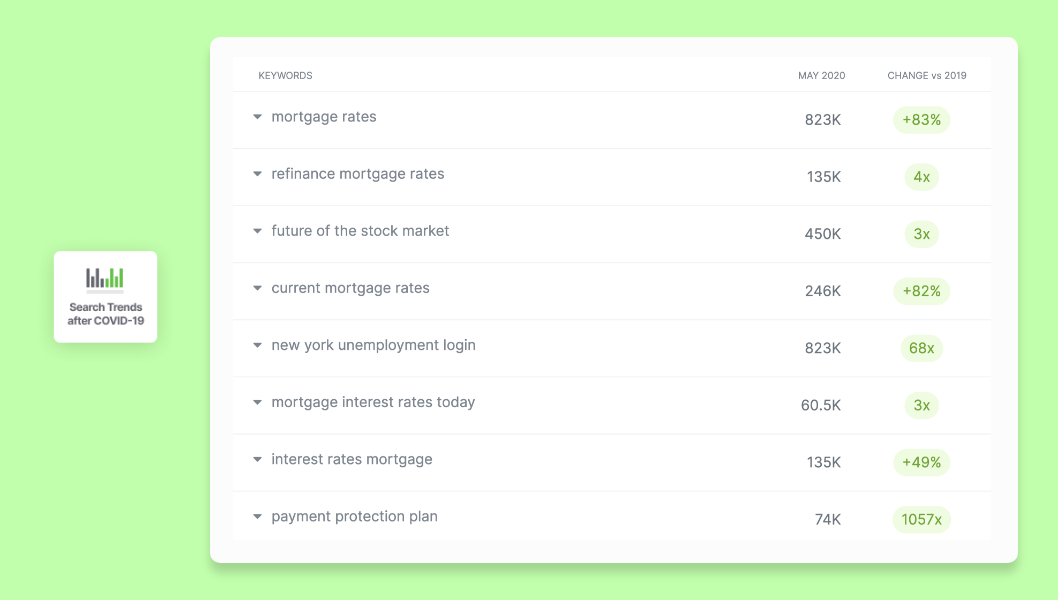

Following this thread, pragmatism is the driving force, as many consumers will not get back to “normal” anytime soon – a study by the Cambridge Group even coins new profiles whose core is based on immediate COVID-19 response such as Panicked Millennials (focused on household finances) or Pragmatists (focused on reducing non-essential spending).
Yet, a look at search data shows the insights in-between: more discretionary or non-essential goods are starting to bounce back in segments such as “athleisure” clothing or home entertainment, although the industries remain affected.
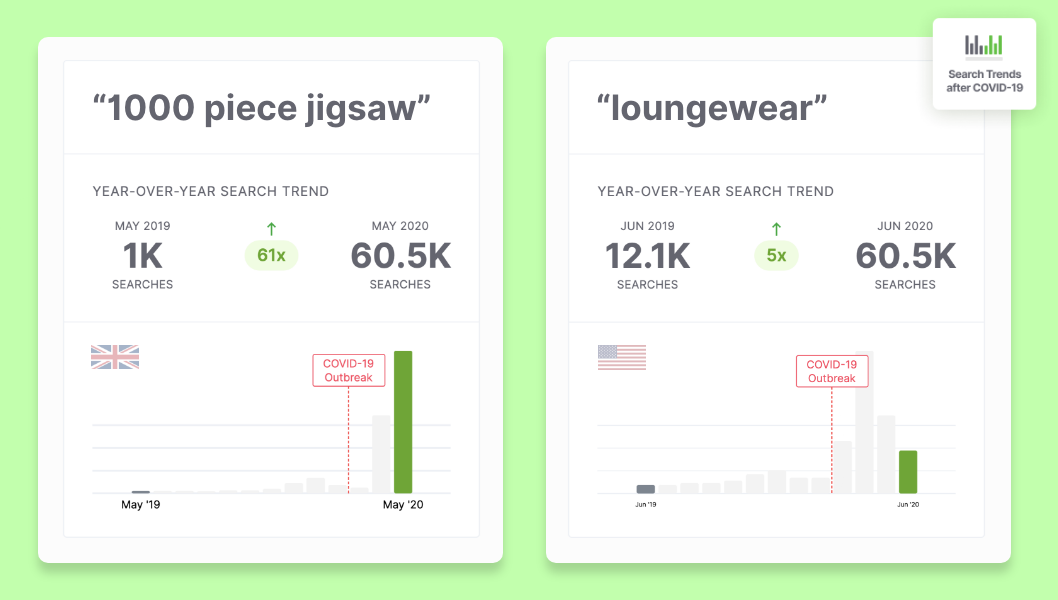

Even the way people look at entertainment shifts, choosing to spend leisure time close to home or in a safe manner:
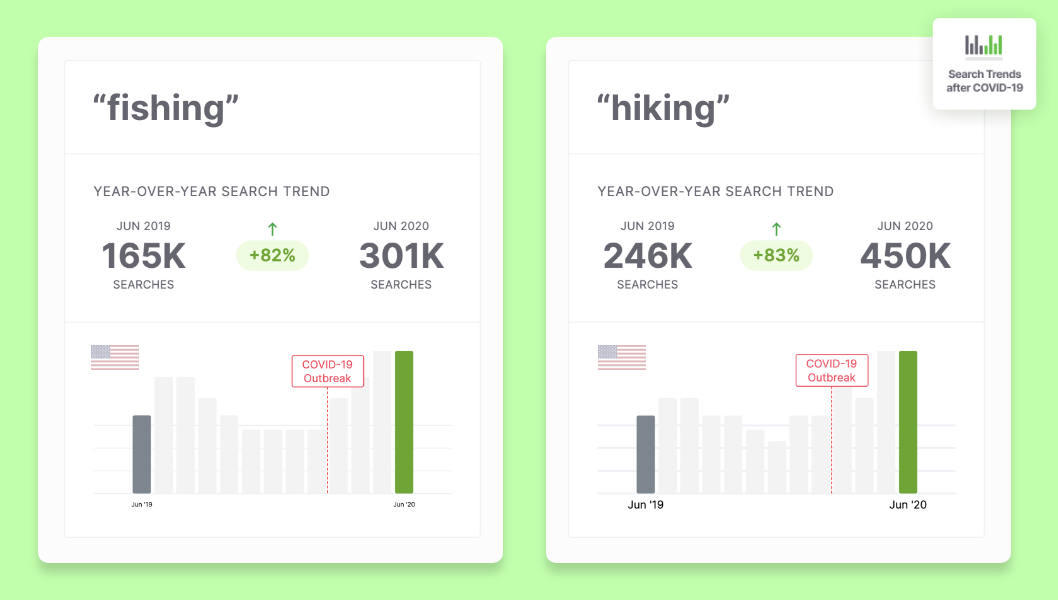

On the other hand, because some people still work or spend most of their time in their houses, together with family and close friends, the home improvement segment continues to grow:
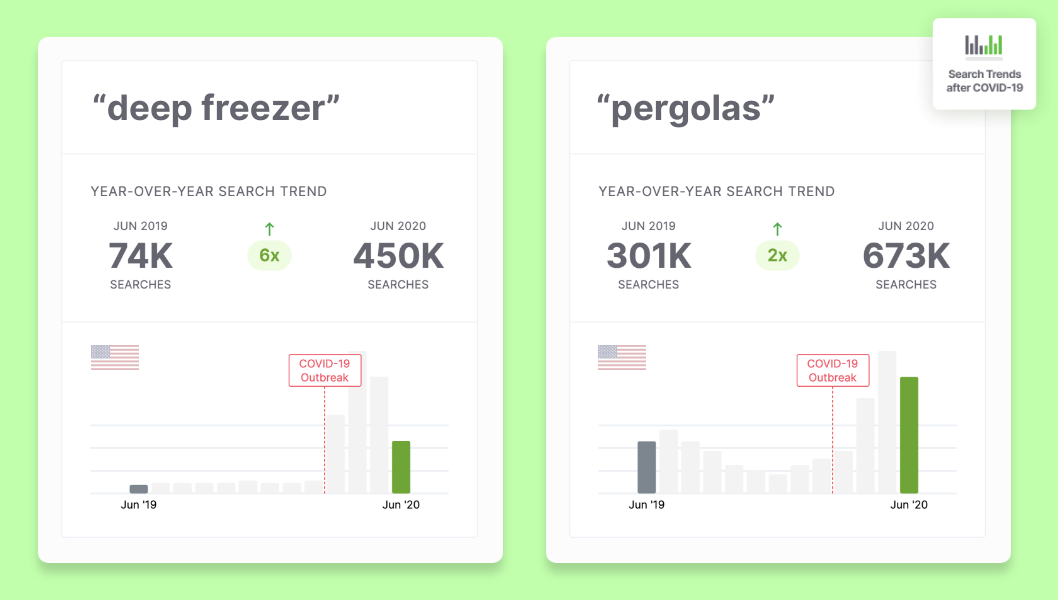

While commute and travel budgets have been put on halt for most information workers, remote work seems to be here to stay. It’s what constant demand for building a home office points toward, anyway:


And a slight rising demand for car rentals and safe, private mobility in general:


Consumer intent reveals an acceleration of shifting channel preferences with a focus on online operations, although macro studies show anxiety levels regarding brick-and-mortar businesses easing a bit.
For instance, the Deloitte State of the Consumer Tracker confirms an increasing tendency in trust levels to shop in stores (49%), go to restaurants (32%), or stay in a hotel (34%) at a global level.
But the numbers remain low.
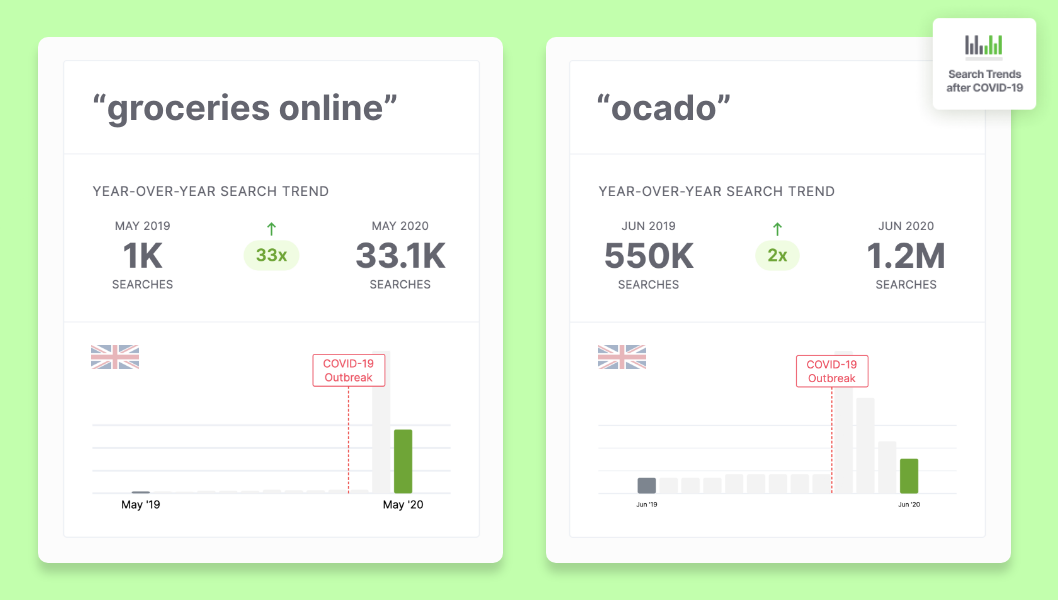

That’s why a prolific avenue is to challenge the macro-level studies with search data – it’s where the relevant insights dwell, helping you discern between lasting trends, spurs of the moment, and important shifts in consumer interest that influence business operations as well.
What Trends Are Emerging That Might Impact SEO Agencies
Having looked at the state of consumers today, which can prove a certain degree of familiarity for your SEO team, it’s important to take this next step – look at the state of businesses and how consumer shifts generate new trends that impact the whole chain.
To pick the most relevant ones for an SEO agency, we’ll employ a different lens: Gartner’s Hype Cycle.
In short, the framework proposed by Gartner enables you to critically assess the promise of emerging technology through these phases:
- Innovation trigger: Although there’s no commercial viability yet, there’s a lot of interest in the potential of a new technology. Take AI for example, everybody’s talking about it.
- Peak of inflated expectations: More publicity and a few success stories, but mostly struggles and failure. The promise of AI to change the world as we know it, right?
- Trough of disillusionment: Interest decreases and investors drop, as the technology fails to deliver the initial promise. Only a few developers insist.
- Slope of enlightenment: Second- and third-generation products appear as the technology begins to stabilize and show other use cases that prove to be viable. Machine learning and deep learning have strong usability segments, far from the initial sci-fi scenarios.
- Plateau of productivity: The technology is applied across sectors and markets, and assessment criteria for viability are clearer now. Machine learning adoption rates continue to steadily grow.
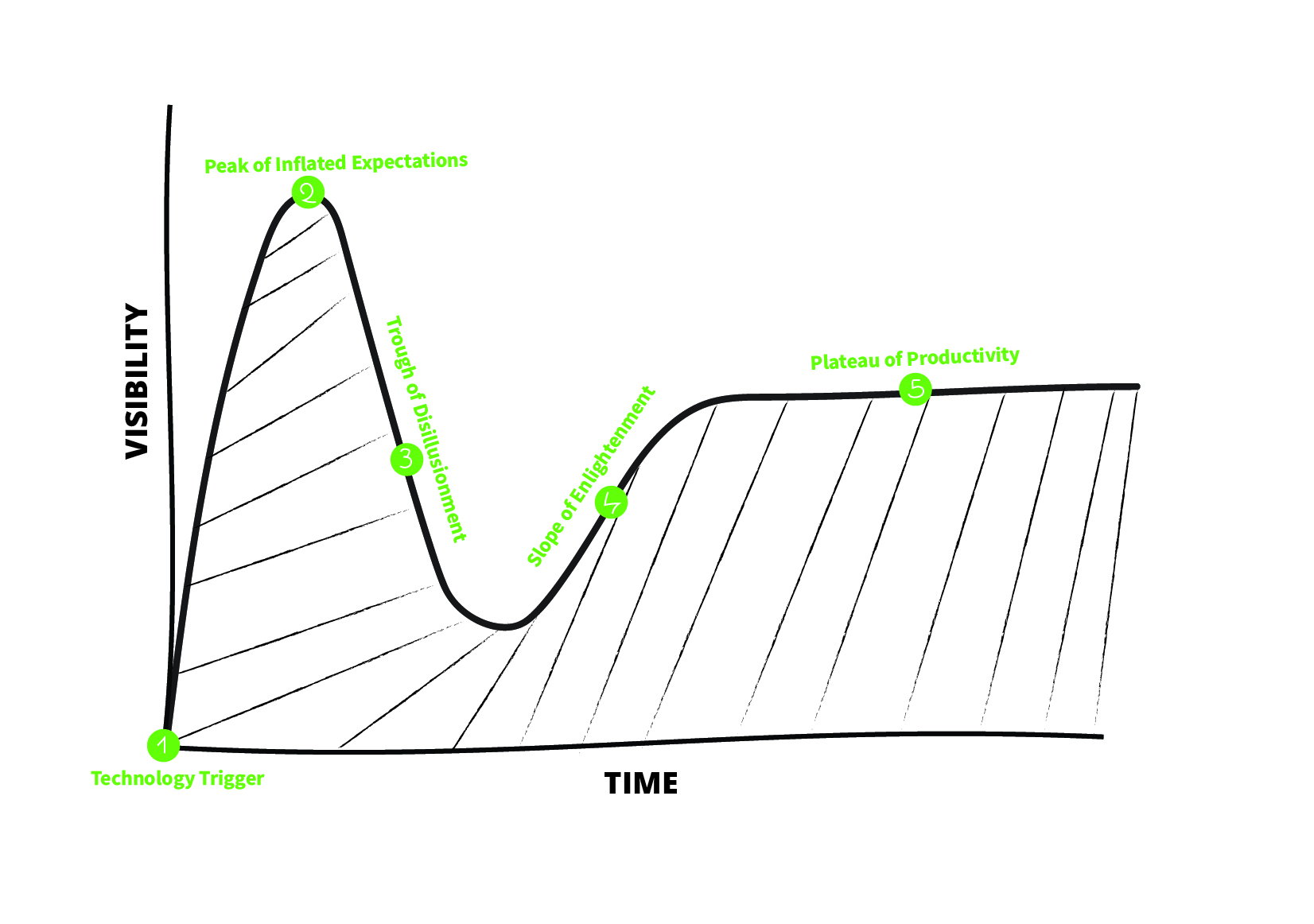

What emerging trends can impact the current agency landscape, beyond the trough of disillusionment?
1. Remote Working as a Viable Company Set-Up
Even before the pandemic hit, the rise of remote working was visible. If the trend seemed to be somewhere between experimenting and a productive framework, with its acceleration due to COVID-19, remote work is becoming a big part of the new normal.
Recently, we’ve seen geographical constraints move to timezone ones, especially for synchronous companies that do most of the work together.
The challenge remains to innovate both at the level of technology and business processes to transform workflows, while also maintaining a strong organizational culture.
In addition, that means a different way of doing recruitment, supporting career growth or enabling social connections in a team. That’s what Remote: office not required explores, presenting how Basecamp designed a remote-first company with all the advantages and struggles.
It’s clear that the trend is here to stay, reshaping such things as telecommuting, client relationships or individual and team productivity.
2. No-Code Is Filling the Gaps of ‘Software as a Process’
Software companies, in their bid to acquire more users, have started developing highly personalized solutions, influencing a business process from start to finish. That’s why, we’re seeing a shift in thinking about software – not just a tool, but a string of actions that dictate a certain business framework and a specific market segment.
For instance, tools like Zapier or Integromat allow for a high level of business flow customization, while Jupiter is a CRM dedicated to the beauty industry.
If we consider this business need for fast implementation and high customization, one particular trend stands out. No-code, a movement where people without programming expertise build websites and flows, like connecting two systems, using drag and drop interfaces, is growing past the early days of inflated expectations.
Transforming the traditional software development flow from “business specifications” to “software implementation”, no-code essentially implies less time and money spent on coding, and more resources for optimizing business processes (marketing, sales, etc.) and discovery.
Think about helping, let’s say, an AC installation supplier set up a customer management system personalized with an automation solution for qualifying leads and scheduling visits, without human intervention at every step. Or building a custom feature on top of HubSpot, to satisfy your agency specialized flows. And with no focus on the technical resources, but the process design.
3. Businesses (SMBs & Fortune 500) Are Willing to Experiment More in the Digital Environment
Talking about discovery and experimentation, the pandemic forced both small businesses and large corporate companies to look for alternatives, as digital became a primary channel for the whole funnel. If a marketing or sales backlog was available, the pandemic months were the time to review it.
It’s no wonder that the search for “Shopify” exploded in May, as more businesses needed to sell online:
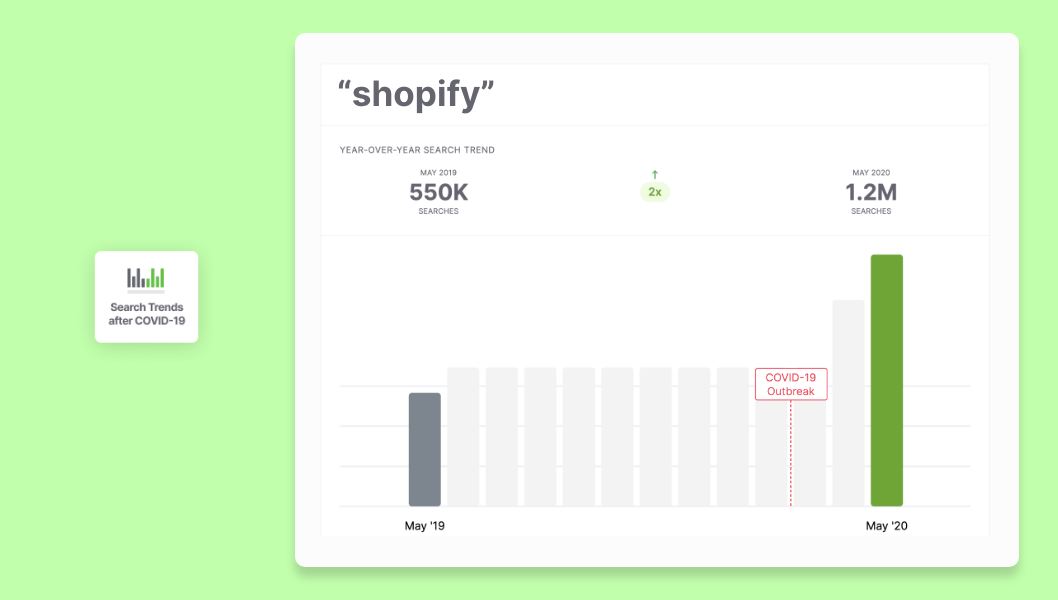

Digital-first frameworks have accelerated, or as a McKinsey report puts it, “we have vaulted five years forward in consumer and business digital adoption in a matter of around eight weeks.”
This creates a window of opportunity for creativity and innovation, as more business processes move in digital environments: from optimizing digital infrastructure to pivoting client management and communications, rehashing customer journeys, and even identifying new segments, niches or markets that are no longer out of reach.
That also means a plethora of data needs and a way for SEO agencies to leverage their know-how.
4. Search & Discovery Fragmentation
In the U.S., more than half of the consumers start their buying journey on Amazon, instead of Google Search, statistics that you’re probably familiar with. Google is also aware of this trend, which makes them continue to develop vertical aggregators like Jobs or News. And that is only one part of the search equation that goes beyond a “box and the 10 blue links”, being now more dependent on behaviors than anything else.
With the fast digitization of businesses after COVID, the trend of search and discovery fragmentation is accelerating at a higher rate, challenging businesses to respond to these channel shifts while thinking more about touchpoints and a buyer quest than a seamless, singular journey.
Can this be the birth of a new innovation trigger?
5. Business Networking Is Not What It Used to Be
The pandemic drastically impacted business networking, as events are not possible in person, a trend that will probably last longer than expected. The first wave of responses was to move to online events, virtual summits, and a variety of webinars, but there’s also the question of informal talks and sales meetings that need to be rethought in order to maintain the quality of interaction.
As with remote work, the geographical boundaries are not a concern anymore for finding vendors or connecting with peers, which leaves a lot of room for creativity in designing new networking processes.
What will the pitch look like in another few months? Or the sales meeting? Or the agency community meetup?
Probably another innovation trigger is shaping here.
Summary
From a critical assessment of consumer macro-trends against search data, to the way business trends have accelerated in the current context, we’re starting to paint a picture of the new agency landscape.
Which are here for good and which are just a trigger in the Hype Cycle? That’s an open question for you and us both.
Here’s a summary of what we’ve seen so far in terms of Consumers and Trends:
How customers look now:
- Unemployment rates and health concerns remain high, causing anxiety and making people reassess what is essential and what is non-essential for daily living.
- Many consumers will not “get back to normal” as pragmatism is still the driving force for buying something new. Yet, some discretionary or non-essential goods are starting to bounce back, as caution levels waver.
- New consumer profiles are emerging, as they also shift channels of consumption. Online-first pragmatists and panicked millennials are concerned with health and finances, while there is a shy recovery of “brick and mortar” consumption.
- Entertainment continues to grow in the home-related areas or in the safe outdoors.
What trends are emerging that might impact SEO agencies:
- Remote working is a viable company set-up that challenges business operations and organizational cultures.
- No-code is filling the gaps of “Software as a process”, enabling businesses to explore tech solutions fast, with lower costs, while optimizing their processes.
- Businesses (SMBs and Fortune 500) are willing to experiment more in the digital environment, as consumers dictate new sales and marketing funnels.
- Search and discovery fragmentation continues to accelerate, posing the challenge for businesses to rethink buyer journeys.
- Networking is not about events anymore and can be the next big innovation ground.
We’ll continue this series, based on researching our SEO agencies community with a thorough analysis of their business models now and what the shifts in 2020 can inspire for reshaping the next-level agency.
You can sign up here and be the first to receive the following articles in the series, once they’re live.
At SEOmonitor, we’re committed to helping SEO agencies navigate uncertainty, so we adapt our solutions to the current context. Search Trends, the Client Health Tracker, or the Reporting board are just a part of our specialized tools and resources.
We’ll get through this together!
Sorry, the comment form is closed at this time.